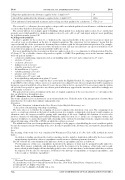Page 534 - SAIT Compendium 2016 Volume2
P. 534
IN 60 Income Tax acT: InTeRPReTaTIon noTes IN 60
Ships that quali ed for the allowance (applies before 1 April 1995)
14
Aircraft that quali ed for the allowance (applies before 1 April 1995)
14bis
New and unused environmental treatment and recycling asset that quali ed for a deduction
37B (2) (a)
The section 11 (o) allowance does not apply to a depreciable asset which quali es for an allowance or deduction under a section other than those listed in the above table.
The section will not, for example, apply to buildings which qualify for a deduction under section 11 (g), intellectual property assets which qualify for a deduction under section 11 (gA), (gB) or (gC) and airport and port assets qualifying for a deduction under section 12F.
4.1.4 Expected useful life
In order to qualify for the section 11 (o) deduction, the expected useful life of the asset for tax purposes must not exceed ten years as determined on the date of original acquisition. The expression ‘for tax purposes’ means that the expected useful life of the asset must be determined in accordance with the relevant deduction provision. For example, an aircraft qualifying for a 20% per year write-off under section 12C may in reality have an expected useful life of 20 years, but for tax purposes its expected useful life will be ve years.
For assets qualifying for the wear-and-tear allowance under section 11 (e) see Annexure A of Interpretation Note No. 47 (Issue 2)* for a schedule of write-off periods acceptable to SARS. Non-qualifying assets in the annexure and their write-off periods include—
• certain air-conditioning components such as air handling units (20 years) and cooling towers (15 years);
• artefacts (25 years);
• escalators (20 years);
• shing vessels (12 years);
• stand-by generators (12 years);
• lift installations (12 years);
• valuable paintings (25 years);
• pleasure craft (12 years);
• portable safes (25 years); and
• water distillation and puri cation plant (25 years).
A capital loss will have to be sought for these assets under the Eighth Schedule. If a taxpayer has obtained approval from SARS to write off any of these assets over a period not exceeding 10 years, the asset in question will be regarded as having an expected useful life of less than 10 years. An asset that is let for a period of 10 years or more must be written off over the lease period as opposed to any shorter period which may appear in the annexure, and will accordingly not qualify under section 11 (o).
The period of ten years is determined on the date of original acquisition of the asset [section 11 (o) (ii)] and not the date on which it was brought into use.
4.1.5 ‘Alienation, loss or destruction’
The words ‘alienation, loss or destruction’ are not de ned in the Act. Under the rules of the interpretation of statutes they must therefore be read in their ordinary and popular sense.
Alienation
The word ‘alienation’ is de ned in the New Shorter Oxford English Dictionary† as—
‘1. the action of transferring ownership of anything’.
The issue arises as to whether the scrapping of an asset comprises the alienation of an asset. The consigning of an
asset to a scrap heap situated on the land of another person (for example, a municipal scrap heap) would comprise an alienation, since the taxpayer would be parting with ownership of the asset. Similarly the donation of an asset also involves a transfer of ownership and would fall within the ambit of section 11 (o). In the case of computer software, the taxpayer would have to ensure that it parts with ownership of the software by deleting it from its computer systems and physically disposing of the CDs or DVDs on which the software is stored.
The withdrawal of an asset from production (for example, for the purpose of mothballing the asset) would not qualify because the taxpayer retains ownership of the asset. In order to qualify for the allowance the asset must be alienated from its owner.
Loss
The meaning of the word ‘loss’ was considered by Watermeyer CJ in Joffe & Co (Pty) Ltd v CIR, in which he stated that‡—
‘in relation to trading operations the word is sometimes used to signify a deprivation suffered by the loser, usually
an involuntary deprivation, whereas expenditure usually means a voluntary payment of money’. In COT v Rendle the court formulated the difference between expenditure and loss as follows:§
‘For the purposes of this case, expenditure incurred for the purpose of trade may be grouped broadly under two heads. First, money voluntarily and designedly spent by the taxpayer for the purpose of his trade; and second, money which is what I might call involuntarily spent because of some mischance or misfortune which has overtaken the taxpayer. For the sake of convenience, I will refer to the rst type of expenditure as ‘designed expenditure’, and to the second as ‘fortuitous expenditure’.’
* ‘Wear and Tear or Depreciation Allowance’, (11 November 2009).
† Lesley Brown, 4 ed (1993) Oxford University Press Inc., New York, United States of America in vol 2. ‡ 1946 AD 157, 13 SATC 354 at 360.
§ 1965 (1) SA 59 (SRAD), 26 SATC 326 at 329.
526 saIT comPendIum oF Tax LegIsLaTIon VoLume 2


